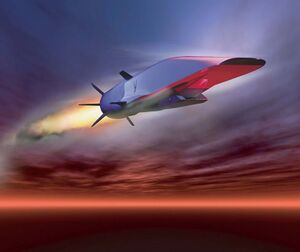GAR-5 Lancer
| Lancer | |
|---|---|
 A render of a Lancer missile in flight. | |
| Type | Anti-ship missile |
| Place of origin | Atlantia |
| Service history | |
| In service | 2020-Present |
| Used by | Atlantia |
| Production history | |
| Manufacturer | EVG |
| Unit cost | US$2,500,000 |
| No. built | 200 |
| Specifications | |
| Weight | 3,528 kg (7,778 lb) |
| Length | 9.28m |
| Diameter | 13.5 in (34 cm) |
| Warhead | 500 kilograms (1,100 lb) |
Detonation mechanism | Impact fuze or airburst |
| Engine | 1st stage solid fuel rocket, 2nd stage scramjet, 3rd stage hypergolic thrusters |
| Wingspan | 1.2 m (3.9 ft) |
Operational range | up to 1000 km depending on trajectory |
| Flight altitude | Sea skimming, ballistic trajectory |
| Speed | 9,261 kilometres per hour (5,755 mph), Mach 27 (Re-entry) |
Guidance system | Active radar homing/inertial guidance and terminal active radar |
Launch platform | multi-platform |
The GAR-5 Lancer (Long-range Airborne Nautical and Celestial Engagement/Reentry) is an Atlantian-built surface-to-surface, anti-ship and ballistic missile developed and manufactured by Europäische Verteidigungsgruppe (EVG, English: European Defence Group). It is designed to be a multipurpose missile system that is able to achieve hypersonic speeds.
The GAR-5 Lancer is currently one of the fastest missiles in the world and is able achieve a range of up to 1000 kilometres depending on the trajectory it takes. Travelling at speeds of 9261 km/h or Mach 7.5 in atmosphere, it is designed to function as a sea-skimming anti-ship missile, ballistic missile and anti-satellite weapon. The missile is primarily launched from either ship or ground-based launchers but a recent modification has allowed the missile to be air launched.
Variants
The GAR-5 Lancer has been developed into several variants since its first deployment with the Atlantian Navy.
- GAR-5A STEM - Shipborne Tracking and Engagement Missile, the ship based version of the Lancer missile which, in addition to receiving on board radar guidance, also receives target tracking and guidance from ship based radar systems.
- GAR-5B SLAM - Submarine Launched Arcing Missile, submarine launched version that can be launched out of vertical submarine launch bays and torpedo tubes. Features a 4th stage consisting of a underwater booster to launch it out of the water.
- GAR-5C AGHL - Assisted Ground Hard Launch, ground based version designed to be fired out of mobile launch batteries such as the Speerwerfer 2.
- GAR-5D ABEM - Aircraft Boosted Engagement Missile, the aircraft-launched variant of the Lancer. If paired with modern aircraft, the ABEM can directly interface with the plane's avionics and receive increased guidance and tracking data.
Description
The GAR-5 Lancer is designed and built by EVG, a joint European defence contractor. The missile is designed to be used against a wide variety of targets: including naval vessels, ground targets and satellites. The missile is configured to be of modular design and allows for the installation of a variety of boosters, warheads and fuel capacities to suit the mission at hand. It is also designed to be able to carry a small tactical nuclear warhead as well.
The GAR-5, when used in an anti-ship role, functions like a traditional sea-skimming anti-ship missile. When launched, the GAR-5 is boosted out of its launching tube via solid fuel launch assist boosters that pull it clear from the launcher and up to supersonic speeds, allowing the scramjet to kick in and begin providing thrust. The missile then turns and heads towards the sea and begins it's sea-skimming cruise. It is at this time the scramjet begins to provide immense acceleration, and brings the missile up to hypersonic speeds of over Mach 7. The missile remains undetectable by the radar horizon at this time and is only detected up to 10 kilometers away. By this time the missile is travelling at approximately 2.5 kilometers per second, giving the ship only 4 seconds to react, massively increasing the missile's survivability. The missile relies upon both the sheer amount of kinetic energy generated by the impact and the warhead onboard to do damage. In addition, the missile carries several smaller warheads that can be independently targeted to increase damage potential.
The GAR-5 can also be used to engage satellites and other high flying objects. The missile, when launched, travels on a pre-programmed intercept course that involves the scramjet being used to give the missile enough delta-v to reach the satellite's height. When the scramjet cannot function no longer due to the lack of air, it is jettisoned and the final stage; a hypergolic thruster system, activates and performs the terminal attack phase. The warhead is designed to perform a distanced burst that sends shrapnel at the satellite, shredding it. Using this method, the GAR-5 can also be used as a ballistic missile; the scramjet boosts the missile onto a ballistic arc. When the missile begins reentry, the missile acts like dart and the hypergolic thrusters perform terminal course corrections. This combined with terminal active radar guidance allows the GAR-5 to be extremely accurate, with a CEP of only 10m, allowing it to effective engage small targets like radar stations and unit formations.
Export
On August 1st, 2021, the Empire of Tserra (formerly the Republic of Tserra), a close ally of Atlantia, announced it would purchase 8000 Lancer missiles for 15 billion dollars with a 25% discount. It specified 6000 missiles for the Tserran Navy's surface vessels, 1000 missiles for land based launch systems (mostly consisting of shore based batteries) and another 1000 for the Tserran Air Force.
